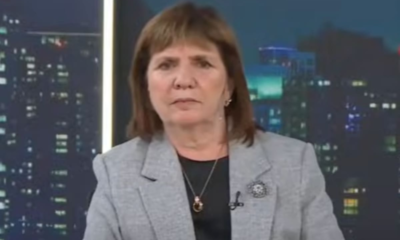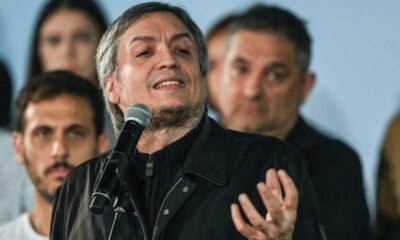INTERNACIONAL
Convicted cardinal announces he won’t be part of conclave to choose Pope Francis’ successor

A cardinal who was forced by Pope Francis to resign his Vatican job and was later convicted of embezzlement will not take place in the upcoming conclave to choose the next pope.
Cardinal Angelo Becciu, 76, announced Tuesday, «Having at heart the good of the church, which I have served and will continue to serve with fidelity and love, as well as to contribute to the communion and serenity of the conclave, I have decided to obey as I have always done the will of Pope Francis not to enter the conclave while remaining convinced of my innocence.»
Becciu was once an influential Vatican chief of staff who was a leading papal contender himself, according to the Associated Press. But he fell from grace in 2020 when Francis forced him to resign his job as head of the Vatican’s saint-making office and his rights as a cardinal because of allegations of financial misconduct in relation to the purchase of a building in London.
Becciu denied wrongdoing but was put on trial in the Vatican criminal court and convicted of finance-related charges in December 2023. He is appealing the conviction and 5 1/2-year prison sentence and had participated in the pre-conclave meetings, including on Monday.
Cardinal Angelo Becciu greets Cardinal Matteo Zuppi during a consistory ceremony to elevate Roman Catholic prelates to the rank of cardinal, at Saint Peter’s Basilica at the Vatican in August 2022. (Reuters/Remo Casilli)
BIDEN PRAISES LATE POPE FRANCIS IN OP-ED, SLAMS MODERN LEADERS WHO ‘EMBRACED CRUELTY’
Italian daily Domani reported last week that during the initial pre-conclave discussions, Becciu was presented with two letters signed by Francis before he died saying he should not participate in the conclave.
Becciu is under the age limit of 80 and technically eligible to vote, but the Vatican’s official statistics list him as a «non-elector.»
CARDINAL DOLAN GIVES INSIDE LOOK INTO CONCLAVE
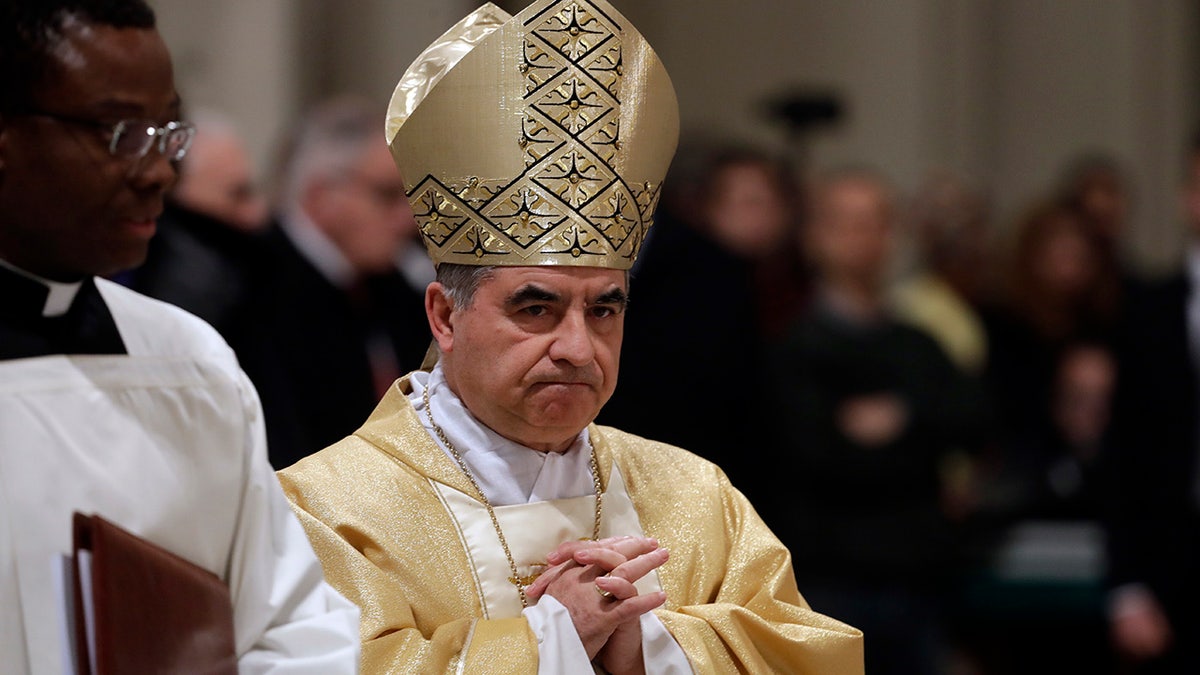
Angelo Becciu presides over a Eucharistic liturgy at the St. John in Latheran Basilica in Rome in February 2017. (AP/Gregorio Borgia)
The conclave is set to begin next Wednesday, while Becciu’s appeal will unfold in September.
Cardinal Gregorio Rosa Chavez of El Salvador, an 82-year-old who is not eligible to vote in the conclave, said Tuesday that «I have the impression that the conclave will be short, two or three days, this is the feeling we have inside the room,» according to Reuters.
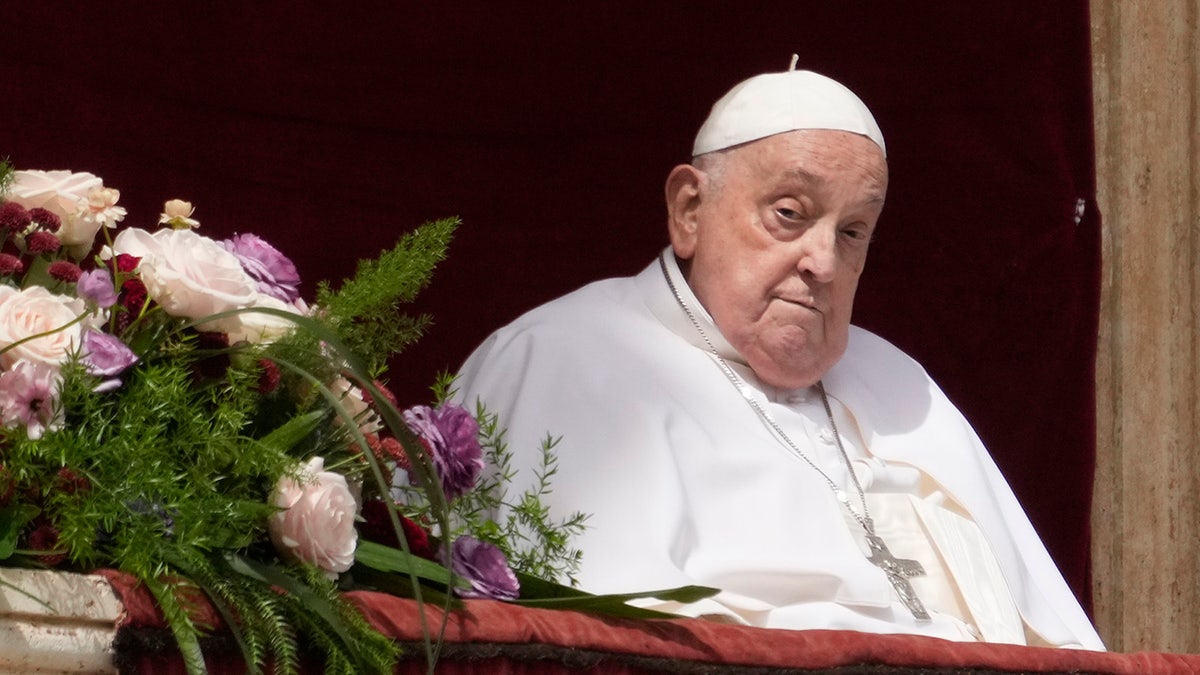
Pope Francis appears on the central lodge of St. Peter’s Basilica to bestow the Urbi et Orbi (Latin for to the city and the world) blessing at the end of the Easter mass presided over by Cardinal Angelo Comastri in St. Peter’s Square at the Vatican on Sunday, April 20. (AP/Gregorio Borgia))
CLICK HERE TO GET THE FOX NEWS APP
The Vatican recently announced «the Sistine Chapel will be closed to the public from Monday 28 April 2025 for the requirements of the Conclave.»
The Associated Press contributed to this report.
INTERNACIONAL
Columbia caminó por la cuerda floja en su camino hacia un acuerdo de 200 millones de dólares con Trump

Justo después del Día de los Caídos, Claire Shipman, presidenta interina de la Universidad de Columbia, visitó a Linda E. McMahon, secretaria de educación del presidente Trump. La institución y la administración Trump se encontraban en un punto muerto por el antisemitismo en el campus, y la mayor parte de los 1.300 millones de dólares en fondos federales para investigación de Columbia estaban en peligro.
Fue una reunión difícil, pero hubo momentos sorprendentemente colaborativos. La Sra. McMahon dijo que no le interesaba destruir la universidad. Empatizó con lo difícil que era dirigir una gran organización. Quería hablar de temas más allá del antisemitismo, como la necesidad de tolerar diversas voces en los campus.
En lugar de desestimar esas preocupaciones de plano, la Sra. Shipman, experiodista y copresidenta del consejo directivo de Columbia antes de asumir la presidencia interina, escuchó.
Fue un momento revelador que contribuyó a los trascendentales acontecimientos del miércoles.
Esa noche, se reveló que Columbia y la administración Trump habían llegado a un acuerdo que permite que cientos de millones de dólares de fondos federales para investigación vuelvan a fluir a Columbia. El acuerdo pone fin a las investigaciones de derechos civiles sobre antisemitismo en la universidad. A cambio, Columbia pagará una multa de 200 millones de dólares al gobierno y 21 millones adicionales para resolver las demandas por discriminación laboral. Un monitor independiente informará al gobierno sobre el cumplimiento del acuerdo por parte de la universidad.

Aunque hubo aspectos en los que no coincidieron, la Sra. Shipman y otros líderes de Columbia coincidieron en gran medida con Washington en que existía un problema de antisemitismo en el campus. Según una encuesta reciente encargada por Columbia, el 62 % de los estudiantes judíos del año pasado afirmaron no sentirse aceptados por su identidad religiosa en la universidad. Algunos consideraban que también existía un problema más amplio de intolerancia, ya que demasiadas personas optaban por excluir, en lugar de interactuar, con otros puntos de vista.
Así pues, la Sra. Shipman buscó lo que llamó las “semillas” de la verdad en los asuntos citados por la Casa Blanca, incluyendo lo que percibía como una ortodoxia académica en el campus o la incapacidad de escuchar otras voces. Ella y otros líderes de Columbia se convencieron de que podían negociar un acuerdo con Trump para abordar los aspectos del campus que, según ellos, estaban rotos, siempre y cuando no traspasaran sus límites ni comprometieran la libertad académica.
El acuerdo fue inmediatamente criticado por muchos, tanto dentro como fuera de Columbia, por considerarlo una cesión ante la administración Trump. La misma táctica de retener fondos para investigación científica para presionar a Columbia por los disturbios en el campus probablemente era ilegal, según dictaminó un juez de Massachusetts. Sin embargo, algunos en el campus, en particular aquellos preocupados por el futuro de la investigación científica, aplaudieron el acuerdo, con la esperanza de que permitiera a Columbia recuperar su estabilidad.
“Entiendo perfectamente el deseo de una narrativa simple: capitulación versus valentía, o hablar versus luchar”, declaró la Sra. Shipman en una entrevista con The New York Times el miércoles. “Miren, como experiodista, me inclino por esos temas. Pero supongo que todos sabemos que las situaciones de la vida real son profundamente complejas. Y realmente diría que proteger nuestros principios, lenta y cuidadosamente mientras estabilizamos la institución, también requiere valentía y está lejos de ser una capitulación”.
Este relato de cómo y por qué Columbia decidió llegar a un acuerdo con la administración Trump en lugar de litigar se basa en entrevistas con seis personas con conocimiento de las negociaciones, la mayoría de las cuales hablaron bajo condición de anonimato para poder hablar de conversaciones privadas.
Columbia ha enfrentado disturbios en el campus desde los ataques de Hamás del 7 de octubre de 2023. El estallido de sentimiento del lado pro-palestino, que aprovechó el momento como una oportunidad para pedir la liberación de Palestina, tomó a muchos por sorpresa. A las pocas semanas de los atentados, mientras los estudiantes judíos e israelíes aún lloraban a sus muertos, estallaron en el campus enfrentamientos a gritos entre estudiantes proisraelíes y propalestinos, acusándose mutuamente de apoyar el genocidio.
El movimiento estudiantil propalestino de Columbia galvanizó el campus, logrando el apoyo de miles de personas. La mayoría de los estudiantes que votaron en referendos no vinculantes apoyaron la desinversión en Israel, cuyas bombas caían sobre Gaza. Sin embargo, algunos estudiantes judíos se sentían cada vez más aislados y asustados. Cánticos como “no queremos sionistas aquí” parecían dirigidos a ellos personalmente.
Minouche Shafik, entonces presidenta de Columbia, no pudo controlar el creciente activismo estudiantil y se negó a llegar a un acuerdo con los manifestantes para desinvertir. Decretó el cierre del campus y llamó al Departamento de Policía dos veces para poner fin a las manifestaciones. Apenas unas semanas antes del inicio del nuevo año académico, en agosto de 2024, dimitió. Aun así, los problemas de Columbia siguieron siendo en gran medida un asunto interno, hasta que el presidente Trump fue elegido.

El 7 de marzo, el gobierno federal canceló o congeló más de 400 millones de dólares en fondos de investigación, argumentando que Columbia ya no cumplía los requisitos para recibir el apoyo debido a su presunta tolerancia al acoso antisemita en el campus. Fue la primera universidad en ser sancionada de esta manera. Harvard, Cornell y Northwestern le siguieron poco después. Un grupo de trabajo sobre antisemitismo que Trump reunió tras llegar a la Casa Blanca emitió una lista de nueve demandas que reflejaban las peticiones de algunos grupos judíos en el campus, solicitando más restricciones a las manifestaciones, mayor supervisión académica y una disciplina más estricta.
La junta directiva de Columbia, compuesta por 21 miembros, en consulta con los abogados de la universidad, decidió negociar. Los abogados informaron a la junta que demandar probablemente traería beneficios a corto plazo, pero que el gobierno aún podría excluir a Columbia de la consideración para futuras subvenciones. Esto generaría una situación extremadamente inestable, que pondría en riesgo miles de millones de dólares de importantes fondos de investigación.
Durante la presidencia interina de Katrina Armstrong, la junta llegó a un acuerdo con el que consideró viable. La universidad modificó cada exigencia de forma que no comprometiera sus valores fundamentales ni la independencia académica.
En lugar de una prohibición total del uso de mascarillas, por ejemplo, se exigiría a los manifestantes enmascarados que mostraran una identificación cuando se les solicitara. En lugar de someter al departamento de Estudios de Oriente Medio a administración judicial, una medida que eliminaría su independencia, un nuevo vicerrector revisaría el trabajo del departamento, junto con el de otros departamentos.
“Si podemos hacer algo que ya teníamos pensado hacer sin tener que litigar y restaurar lo que nos importa aquí, ese es, en nuestra opinión —o en la mía—, el mejor camino”, declaró Keith Goggin, miembro del consejo, en una asamblea pública del senado universitario en primavera. “Y quizá no podamos seguir ese camino, pero ahí estamos hoy”.
La Sra. McMahon, secretaria de educación, afirmó públicamente que Columbia iba por buen camino. Sin embargo, días después, la Dra. Armstrong fue duramente criticada por cómo describió el acuerdo en una reunión privada del profesorado. Una transcripción de la reunión se filtró a los medios, insinuando que estaba minimizando su compromiso con cambios reales. A los pocos días, renunció y la Sra. Shipman la sucedió.
A principios de abril, la Casa Blanca presentó a Columbia los términos de un decreto de consentimiento, un plan de mejora del rendimiento legalmente vinculante que generalmente implica una orden judicial y que dejaría a Columbia bajo supervisión federal durante los próximos años. El plan, mucho más estricto que el acuerdo final, se filtró a la prensa y se presentó como inminente, a pesar de que las negociaciones continuaban.
El 11 de abril, Harvard publicó su propia carta de la Casa Blanca, que exigía aún más a la universidad que recuperara miles de millones de dólares en financiación para la investigación. Sintiendo que su independencia estaba en juego, Harvard declaró que demandaría, no negociaría. De repente Washington tuvo ante sí una situación más urgente y cambió su enfoque.
El tiempo extra ayudó a Columbia a consolidar su estrategia de negociación. A medida que se retiraban miles de millones de dólares de Harvard y se ponía en duda su capacidad para matricular estudiantes internacionales, lo que estaba en juego se hizo evidente. También se hizo evidente internamente en Columbia que el golpe a su iniciativa científica era mucho mayor que los 400 millones de dólares originales.
Columbia ahora afirma que la mayor parte de sus 1300 millones de dólares en subvenciones federales anuales se había congelado o suspendido. También se le prohibió a la universidad competir por nuevas subvenciones. En mayo, cerca de 180 personas fueron despedidas. Cada día, los científicos recibían nuevas ofertas y tenían la incertidumbre de si Columbia seguiría siendo un centro de investigación importante.
El gobierno continuó aumentando la presión, abriendo nuevas investigaciones sobre violaciones de los derechos civiles contra estudiantes judíos en Columbia. A finales de mayo, el gobierno federal declaró a Columbia violando las normas de derechos civiles por “actuar con deliberada indiferencia” ante el acoso a estudiantes judíos. En junio, el Departamento de Educación envió una carta al organismo que otorga a Columbia y otras escuelas un sello vital de aprobación (la acreditación) y advirtió que la universidad podría perder esa credencial vital, clave para recibir ayuda federal para estudiantes.

Todos estos eran problemas muy reales que debían resolverse con el gobierno.
“Pensamos que tenía sentido seguir dialogando mientras se lograran avances”, dijo la Sra. Shipman.
Mantuvo múltiples conversaciones con la Sra. McMahon y miembros de su personal, según una persona con conocimiento de las conversaciones. La Sra. Shipman también habló con abogados de las agencias que integran el grupo de trabajo sobre antisemitismo de la administración Trump, así como con representantes de la Casa Blanca y el Departamento de Justicia.
La Sra. Shipman trabajó con los fideicomisarios y un pequeño equipo académico que reunió. Este incluía a un experto en negociación, quien les indicó que es posible llegar a un acuerdo, incluso con un oponente con el que se tienen profundas diferencias, siempre que se mantengan los principios fundamentales.
El trabajo fue minucioso. “En realidad, es un acto de equilibrio”, dijo la Sra. Shipman, aproximadamente una semana antes de que se anunciara el acuerdo. “Queremos este acuerdo, lo necesitamos. Queremos recuperar una buena relación con el gobierno y volver a ser un socio de investigación. Y, sin embargo, debemos proteger algunos aspectos fundamentales de nuestra identidad como institución”. Se selló un acuerdo.
Pareció producirse un avance en las negociaciones cuando la Casa Blanca propuso multas monetarias para ayudar a resolver las quejas sobre derechos civiles. Las partes también acordaron nombrar a un monitor independiente, a quien elegirían mutuamente. El monitor garantizaría el cumplimiento de los términos del acuerdo.
Columbia adoptó un enfoque práctico respecto a la enorme tarifa del acuerdo. El dinero era menos importante que los valores fundamentales: Columbia consideraba que este acuerdo no dictaría quién enseña, qué enseña ni qué estudiantes son admitidos.
“No se trata de una cantidad de dinero que nos quiebre, pero los valores fundamentales son la clave”, dijo un alto administrador académico de Columbia involucrado en las negociaciones.

A juicio de los negociadores de Columbia, gran parte de lo acordado —el compromiso de respetar las leyes de derechos civiles y no participar en prácticas ilegales de diversidad— habría sido necesario de todos modos bajo la administración Trump. La mayoría de las reformas internas, como la centralización del control disciplinario estudiantil y el nombramiento de al menos 36 agentes de seguridad con facultades de arresto, son cambios a los que ya se habían comprometido.
Para la semana pasada, se estaba cerca de un acuerdo. Un equipo de funcionarios y abogados de Columbia, incluida la Sra. Shipman, se reunió en una sala de recepción diplomática de la Casa Blanca durante una hora con May Mailman, estratega política, y otros funcionarios de Trump para discutir algunos detalles finales.
“El daño a Columbia no fue especulativo. Fue real y real”, declaró Jeh Johnson, copresidente de la junta y secretario de Seguridad Nacional durante la administración Obama.
“Sin una resolución con el gobierno, nos enfrentábamos a la pérdida de nuestra actividad de investigación tal como la conocemos, incluyendo la salida de nuestros mejores científicos y, sin duda, más despidos”, declaró el Sr. Johnson. “Teníamos que detener la hemorragia”.
© The New York Times 2025.
Crime,Asylum / Immigration / Refugees,North America,NEW YORK
INTERNACIONAL
Una exposición de manuscritos de hace 1.300 años muestra que los monjes no se limitaban a copiar: en los márgenes hay bromas, ironías y quejas

Unos manuscritos medievales de 1.300 años, repletos de garabatos y anotaciones inesperadamente humanas, han salido a la luz en una exposición que desafía la imagen solemne de la vida monástica irlandesa. El Museo Nacional de Irlanda, en Kildare Street, Dublín, presenta hasta el 24 de octubre una muestra que revela cómo los monjes del siglo IX no solo copiaban textos sagrados, sino que también dejaban constancia de sus frustraciones, bromas y temores cotidianos.
Según informó Fox News, estos documentos, junto con más de un centenar de objetos históricos, ofrecen una ventana inédita a la vida y personalidad de los monjes irlandeses, mostrando que la espiritualidad medieval también tenía espacio para la queja, el humor y la preocupación por las amenazas externas.
La exhibición, titulada “Words on the Wave: Ireland and St. Gallen in Early Medieval Europe“, reúne más de 100 piezas de alto valor histórico y cultural, muchas de las cuales se muestran al público por primera vez. El acceso es gratuito, lo que facilita que tanto especialistas como curiosos puedan acercarse a este periodo fundamental de la historia irlandesa. De acuerdo con el reporte de Fox News, la muestra incluye diecisiete manuscritos antiguos cedidos en préstamo por la Biblioteca de la Abadía de San Galo, en Suiza, una de las instituciones monásticas más antiguas de Europa.
Entre los libros expuestos destaca el “Institutiones Grammaticae” de Prisciano, un tratado gramatical del siglo VI que, siglos después de su redacción, se convirtió en el lienzo improvisado de los monjes irlandeses. Según detalló el National Museum of Ireland en declaraciones recogidas por Fox News, este volumen contiene “miles de garabatos en los márgenes escritos en irlandés antiguo”, lo que lo convierte en un testimonio excepcional de la vida intelectual y emocional de sus copistas.

Aunque los manuscritos se conservan hoy en la Abadía de San Galo, su origen se remonta a los monasterios de Nendrum o Bangor, en el norte de Irlanda. Estiman que los monjes irlandeses realizaron estas anotaciones en la década de 850, antes de que los libros viajaran al continente europeo, donde se integraron en la biblioteca suiza en menos de una década.
El “Institutiones Grammaticae” no solo es valioso por su contenido gramatical, sino también por las voces que emergen de sus márgenes. Estos garabatos permiten a los visitantes acercarse a una dimensión poco explorada de la historia monástica.

Lejos de limitarse a copiar textos sagrados, los monjes irlandeses del siglo IX aprovecharon los márgenes de los manuscritos para expresar sus pensamientos más mundanos. Entre los ejemplos más llamativos, recogidos por Fox News y The Guardian, figura la confesión de un monje que escribió estar “ale-killed“, una expresión que indica que sufría una resaca. Esta anotación, traducida como “muerto por la cerveza”, rompe con la imagen de austeridad y recogimiento que suele asociarse a la vida monástica.
Otras anotaciones reflejan las dificultades materiales y climáticas que enfrentaban los copistas. Uno de los garabatos más citados reza: “Nuevo pergamino, mala tinta. Oh, no digo nada más“, una queja que pone de manifiesto los problemas cotidianos de quienes trabajaban en la producción de libros. Además, los monjes no ocultaban sus temores ante las amenazas externas. En una de las entradas, un fraile expresa su preocupación por las incursiones vikingas: “Amarga es la noche, el viento agita el cabello blanco del océano: no temo el curso del mar claro por los fieros héroes de Lothlend”.
El curador Matthew Seaver, en declaraciones recogidas por The Guardian y citadas por Fox News, subrayó el valor de estos textos: “Ofrecen una visión poco común y muy real de la vida cotidiana de los monjes irlandeses medievales”. Seaver añadió que los manuscritos están “llenos de voces humanas, humor, frustración y resiliencia”, lo que permite comprender mejor la complejidad emocional y social de los religiosos de la época.

Para Matthew Seaver, curador del National Museum of Ireland, la importancia de estos manuscritos radica en su capacidad para humanizar a los monjes medievales. Según explicó en declaraciones recogidas por Fox News, los garabatos y anotaciones “ofrecen una visión rara y muy real de la vida diaria y las personalidades de los monjes irlandeses medievales”.
Seaver destacó que estos textos están “llenos de voces humanas, humor, frustración y resiliencia”, lo que permite a los visitantes conectar con los sentimientos y preocupaciones de quienes vivieron hace más de un milenio. El curador también señaló que, aunque muchas de las bromas y juegos de palabras requieren conocimientos de irlandés antiguo para ser comprendidos en su totalidad, la esencia de las emociones y situaciones descritas resulta universal.
La exposición, según Seaver, invita a repensar la imagen tradicional de los monjes como figuras exclusivamente espirituales y a reconocer su humanidad en toda su complejidad.

La muestra no se limita a los manuscritos. Entre los objetos más destacados figuran un broche del siglo VIII, una espada vikinga y el relicario de libros más antiguo y grande de Irlanda, conocido como el Lough Kinale Book Shrine. Estos artefactos, según detalló Fox News, complementan la narrativa de la exposición al ilustrar la riqueza material y simbólica de la Irlanda medieval.
El broche celta, ejemplo de la orfebrería de la época, y la espada vikinga, testimonio de los contactos y conflictos con los pueblos nórdicos, permiten contextualizar las preocupaciones expresadas en los manuscritos. El relicario de libros, por su parte, subraya la importancia que los monjes otorgaban a la conservación y protección de los textos sagrados y literarios.

El presidente del Museo Nacional de Irlanda, Cathal O’Donoghue, destacó la relevancia de la exposición en una declaración recogida por Fox News. O’Donoghue afirmó sentirse “honrado de recibir este préstamo significativo” y calificó la muestra como “la exhibición más significativa en décadas” para la institución de Kildare Street. Según él, la presentación de los manuscritos proporciona “un contexto único para la exhibición de artefactos de nuestra propia colección, muchos de los cuales han sido recientemente conservados y se muestran al público por primera vez”.
La exhibición “Words on the Wave: Ireland and St. Gallen in Early Medieval Europe” permanecerá abierta hasta el 24 de octubre en el National Museum of Ireland, ofreciendo a los visitantes la posibilidad de descubrir, a través de manuscritos y objetos, el lado más humano y cotidiano de los monjes irlandeses medievales.
INTERNACIONAL
Unearthed video exposes Mamdani’s ‘unabashed’ commitment to supporting anti-Israel sanctions as lawmaker
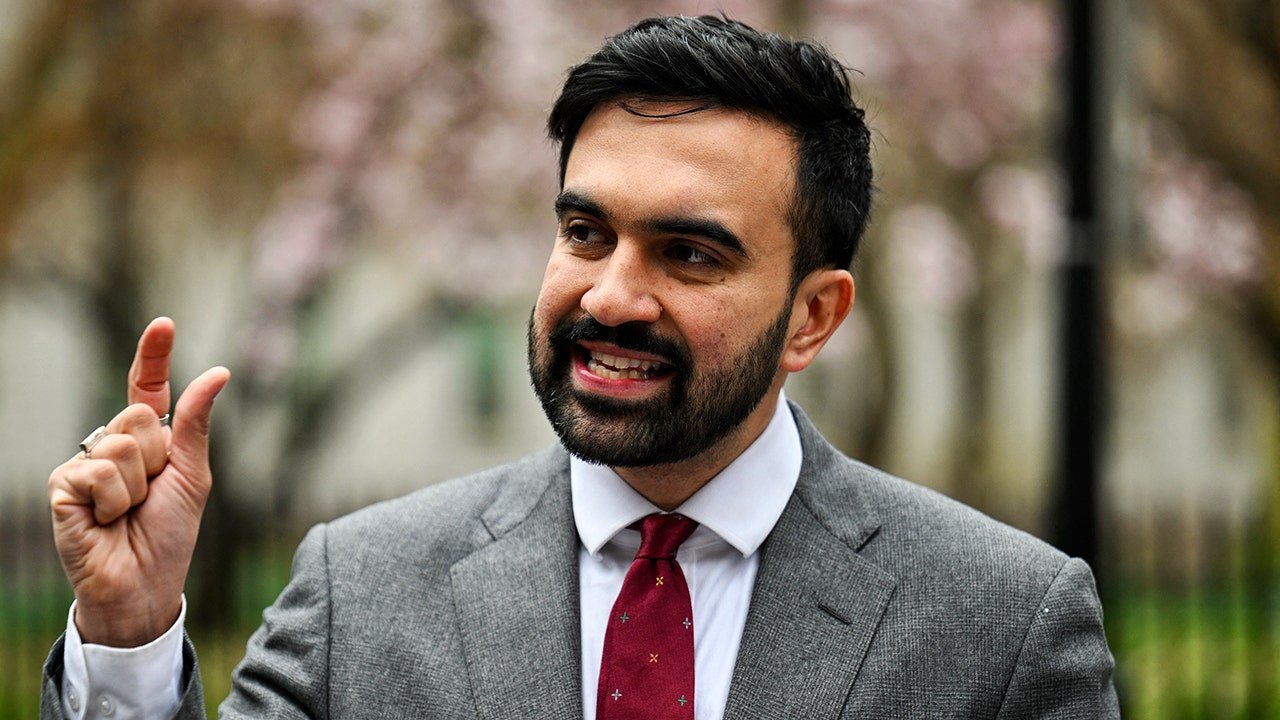
NEWYou can now listen to Fox News articles!
FIRST ON FOX: A resurfaced interview by New York City socialist mayoral candidate Zohran Mamdani highlights his commitment to BDS and sanctions against Israel, as he runs for mayor in a city with the highest Jewish population in the United States outside of Israel.
«I’m very excited about being a member of DSA, specifically the New York City chapter,» Mamdani told SAAG Interactive in June 2021.
«Within the questionnaire when you submit to be considered a candidate to be endorsed by the organization, you’re asked what your views are on BDS and I think that has also brought what it is typically thought of as a separate issue into the sphere of local politics where we create a bench of candidates. We’re not legislating on BDS on a daily basis, but it’s clear that our commitment is unabashed to justice.»
Mamdani was interviewed in the clip by a journalist named Naib Mian, who has a social presence littered with anti-Israel posts, including accusing Israel of benefitting from «manufacturing antisemitism» and defending the phrase «from the river to the sea.»
NYC COUNCILWOMAN WARNS MAMDANI VICTORY WILL DRIVE AWAY KEY VOTING BLOC: ‘AFRAID TO LIVE HERE’
Democratic socialist candidate Zohran Mamdani, who won the Democratic primary for mayor of New York City, speaks at an endorsement event on July 15, 2025 in New York City. (Spencer Platt/Getty Images)
Mamdani went on to speak more about BDS, an acronym for Boycott, Divestment and Sanctions, in the interview, saying that «the ways in which we can marry our struggle to our day-to-day life and show our solidarity in that life, I think that’s critical to winning this fight because it can’t all be, as you’ve very well stated, just kind of exclusively considered a legislative battle. It has to be a society-wide battle.»
«And I think there is no thing that’s too banal to stand up against the brutality of the occupation and apartheid. And so, you know, if it’s a shipping container, or if it is a university that is being funded, a university that helped to develop IDF’s weapons technology, or it is an event with an Israeli ambassador, whatever it may be, I think that we have to showcase what that solidarity looks like.»
Dating back to his college days, Mamdani has expressed support for BDS, which Influence Watch describes as «an international campaign to delegitimize the State of Israel as the expression of the Jewish people’s right to national self-determination by isolating the country economically through consumer boycotts, business and government withdrawal of investment, and legal sanctions.»
MAMDANI’S FORMER DEM COLLEAGUE RAILS AGAINST HIS SIGNATURE CAMPAIGN PROMISE: ‘NAIL IN THE COFFIN’
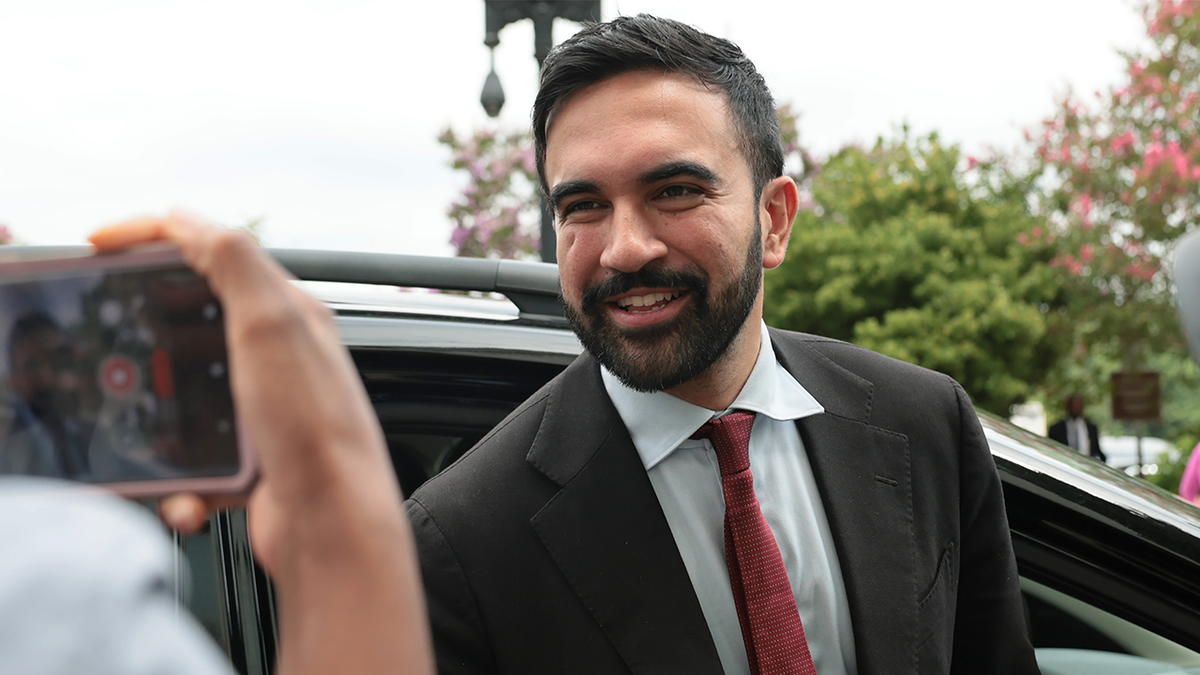
NYC Mayoral candidate Zohran Mamdani briefly speaks with reporters as he leaves the Dirksen Senate Office Building on July 16, 2025 in Washington, D.C. (Photo by Michael M. Santiago/Getty Images)
Mamdani, who founded the Students for Justice in Palestine chapter at the prestigious Bowdoin College in Maine, wrote about the importance of an academic boycott of Israel in the school paper, Fox News Digital previously reported.
«It also helps to highlight just how intertwined this oppression is, and just how much it relies on us normalizing it and saying that, you know, my convictions stop at the point when it becomes inconvenient, and we have to showcase that convenience means nothing in the face of these things,» Mamdani said in the interview. «On a personal level, I am very much committed to actively working to stop any additional anti-BDS bills that come through the Assembly.»
Mamdani told Mian that he has been working on a letter to «circulate to support proactive measures that we can take to stop apartheid and to hold Israel accountable.»
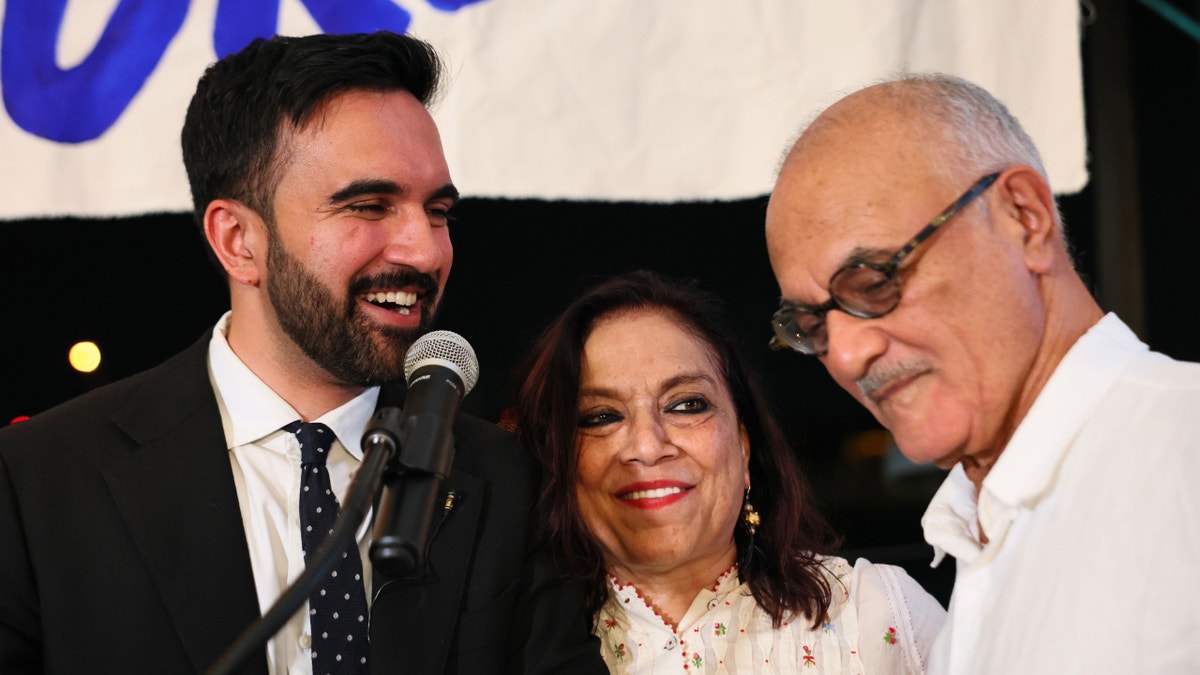
From left to right, New York mayoral candidate State Rep. Zohran Mamdani stands with his mother, Mira Nair, and father, Mahmood Mamdani, as they celebrate during an election night gathering at The Greats of Craft LIC on June 24, 2025 in the Long Island City neighborhood of the Queens borough in New York City. ( (Photo by Michael M. Santiago/Getty Images))
Mamdani continued, «My predecessor was somebody who very much marched in support and showed up at press conferences in support of the Israeli state. And I am somebody who is unabashedly in support of Palestinian liberation. My constituency hasn’t changed that much in between our terms. But it’s very clear to me that my constituency now, after I’ve said these things, the response that I received is just overwhelmingly in support. And so there are so many other people, so many other districts in New York City where people are just waiting to be given the go-ahead to express that solidarity.»
CLICK HERE TO GET THE FOX NEWS APP
Mamdani said that it is «my job» to give those people he previously mentioned «as many opportunities as possible and to push as many other colleagues of mine and people in any place of power to do the same.»
«I really do believe that we have not yet hit the ceiling of support for the Palestinian people’s fight for justice,» Mamdani said.
Fox News Digital reached out to the Mamdani campaign for comment.
Mamdani’s support for BDS has drawn criticism from Jewish groups in New York and his father, Mahmood, has also voiced support for BDS while sitting on the advisory board of a tribunal that has routinely called for sanctions against Israel,» Fox News Digital previously reported.
Mamdani has defended his support of BDS on the campaign trail, including in May where he said, «My support for BDS is consistent with my core of my politics, which is non-violence.»

 ECONOMIA3 días ago
ECONOMIA3 días agoEl consumo en Argentina crece 4% en junio, ante menor inflación y más crédito

 POLITICA2 días ago
POLITICA2 días agoMáximo Kirchner declaró una fortuna de 8.300 millones de pesos: representa un 76% más que el año anterior

 POLITICA22 horas ago
POLITICA22 horas agoLa justicia de Santa Cruz desafío a la Corte Suprema e incluyó a Cristina Kirchner en el padrón electoral















